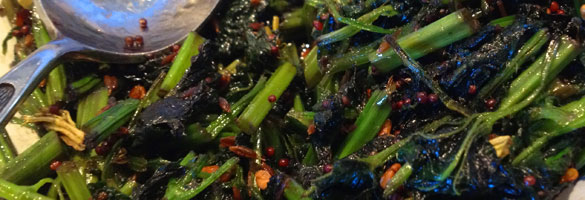A few days ago on facebook I wrote little post on Nettle, and how it could be used as a substitute for a recipe in Food As Medicine called Spciy Saag. Well, yesterday I went into the forest and harvested nettle, along with some miner’s lettuce (Claytonia sibirica) and cleavers (Galium aparine) which all grew in the same area. It’s amazing how many wild edibles there are, probably growing in your backyard. For this recipe, any green vegetable can be used, although Nettles are particularly favored due to their high nutrient content. Here’s a little history on Nettle, taken from my monograph at toddcaldecott.com.
Nettle has a long history of use all over the world as a food, medicine and textile fiber. Weiss properly calls Nettle a ruderale, meaning that it tends to grow around human settlements (1988, 261). Grieve states that the common name of Nettle is derived from the German noedl meaning ‘needle,’ possibly from its sharp sting, or in reference to the fact that it once furnished thread and cloth before the introduction of flax and hemp into Europe (1971, 575). ‘Net’ is stated as being the passive participle of ne, a verb that in many Indo-European languages such as Latin and Sanskrit, means ‘sew’ or ‘bind,’ respectively (Grieve 1971, 575). Nettle was at one time highly esteemed as a textile fiber, and is highly durable, once thought to be the only real equivalent to cotton, used by the third Reich during the second world war as a textile in manufacture of German uniforms (Grieve 1971, 575; Wood 1999, 482). Beyond its importance as a fiber however, Nettle has long been regarded as an important and nutritious green vegetable, one of the first edible green growing things of spring, picked young and eaten steamed or in soups, said to be a good corrector of the bowels. The body of the famous Tibetan yogi Milarepa is said to have turned green from consuming nothing other than Nettle during his meditations. Despite being classified as a weed in many parts of the North America, Nettle was at one time highly prized commodity in rural areas, where the English poet Campbell recounts of his travels, “In Scotland I have eaten nettles, I have slept in nettle sheets, and I have dined off a nettle tablecloth” (Grieve 1971 575). More recently Nettle has been used as a commercial source of chlorophyll, and Weiss states that this color has been used in Germany as a food coloring agent for canned vegetables (1988, 262; Mills and Bone 2000, 490).
Here is the recipe for Spicy Saag, from Food As Medicine:
Saag refers to any kind of stir-fried greens in Indian cookery, prepared with the characteristic Indian spices such as cumin and black mustard seed. While spinach is most commonly used nowadays, saag can be made with any kind of greens, such as amaranth greens found in Chinese markets as hin choy and Indian markets as chaulai. I frequently use the kale and chard in my garden. To boost the nutrient content, I also add in other herbs such as fresh cilantro and fenugreek (methi), or use curry leaf instead.
Ingredients
1-2 lbs of amaranth greens, chopped into 1 inch chunks
½ bunch finely chopped fenugreek (methi)
½ bunch finely chopped cilantro; or, 1-2 sprigs of curry leaves
one-thumb sized piece of fresh ginger, grated
1 tbsp cumin
1 tbsp black mustard seed
½ tsp hing powder
2 tbsp coriander powder
½-1 tsp turmeric
½-1 tsp black pepper
1-2 tsp pink salt (sanchal)
2-3 tbsp ghee
Directions
Melt ghee in a wok or large saucepan at medium heat, and when it begins to glisten add in fresh ginger, cumin and black mustard seed. If you are using curry leaf instead of cilantro, slide the leaves off the curry sprig and into the pan. When the mustard seeds just begin to pop, add in hing, coriander, turmeric, black pepper and pink salt. Stir for a half minute and then add in amaranth greens, turning the heat up a little higher. Cook veggies for about 2-3 minutes on high heat, then reduce it back to a medium heat. Continue to cook, stirring frequently, just until the leaves turn a bright, brilliant green. Serves 2-4 people.
For variations, use different herbs and spices. Have a little gas? Add some ajwain, crushed fenugreek seed or fennel seed. Maybe today the kapha is a little thick and heavy? Add in some red chili powder. Or instead of cilantro or curry leaf, try some Thai Basil instead.


